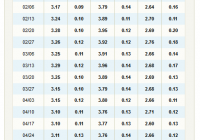Public Service Enterprise: Facing A Long-Term Decline
Summary Public Service Enterprise is facing many headwinds in the form of an unsustainable business model and an aging infrastructure. The company’s continual infrastructure build out should prove to be counterproductive in the long-run. While societal electricity usage will likely increase dramatically over the next few decades, Public Service Enterprise should still feel downward pressure in the long-term. Public Service Enterprise Group (NYSE: PEG ) is currently one of the nation’s oldest and largest electric utilities. The company dominates the New Jersey electricity landscape, providing millions of individuals with electricity. The company has been one of the top performing electric utilities over the past few years, consistently beating investor expectations on many fronts. Despite all of this, PEG will likely underperform investor expectations moving forward. While PEG may continue to do well in the near-term, the company’s long-term prospects are dimmer. PEG is a diversified electric utility, which means that it incorporates all types of energy sources into its business model. While this business model makes it more competitive against non-diversified electric utilities, the company is still too highly valued at $20.74B . The energy landscape is starting to shift away from a one dominated by centralized generation, and PEG will likely be one of the first companies to feel the effects of this change. Given that PEG’s business model has remained unchanged for countless decades, the company should have a hard time adapting to changing realities. Continual Grid Build-Outs Are A Long-Term Negative PEG makes much of its money by building out grid infrastructure in order to sell more electricity. This only makes sense given that the only way to reach more residences/buildings is to expand its grid system. In fact, PEG expects to spend approximately $1.6B in 2015 on its transmission infrastructure. The company’s transmission investments are expected to continue rising moving forward, which could actually dampen the company’s long-term prospects. Such grid investments incur huge sunk costs, as PEG expects to spend $2.6B in upgrades on its electric/gas distribution and transmission systems. While this would be a great investment under the assumption that centralized methods of generation will remain at similar levels of profitability for the foreseeable future, this is far from certain. Distributed generation methods is becoming more promising by the day, especially with the progress being made in energy storage technologies. As such, these growing grid infrastructure investments could very well end up as billions of dollars in unrecoverable sunk costs. Given the rather slim margins of PEG, these investments would only be recouped if individuals continue buying electricity from the company’s power plants at current rates. With the proliferation of alternative energies, distributed generation has become more viable than ever, and could force PEG to reduce electricity costs in order to remain competitive. This will make it increasingly hard for PEG to recoup investments. Given PEG’s centralized generation model, the company needs to continue expanding and maintaining its infrastructure in order to grow. On the bright side, PEG is implementing many grid efficiency programs, which is actually conducive to distributed generation. The company is planning to spend an additional $95M on increasing energy efficiency over the next three years, although this amount is minimal in the grand scheme of things. Given that distributed generators still requires a grid to function, improving grid efficiency is a win for everyone. Regardless, PEG is still spending enormous amounts of money building out its grid, which may actually end up costing the company in the long-run. Aging Infrastructure With PEG’s aging infrastructures, increasing amounts of investments will be needed just to sustain the company’s current grid. Given that PEG has one of the oldest grid systems in the country, grid maintenance investments will likely ramp up moving forward. Even worse, these grid maintenance costs cannot be avoided, which means that more and more of PEG’s expenditures will go purely towards maintaining its current infrastructure. Such a model of centralized generation reliant on a rapidly decaying grid infrastructure is not sustainable in the long-run, and is one more reason why PEG should increasingly lose revenue to distributed forms of generation. On top of this, many policies restrict PEG from entering into the distributed energy game due to concerns about monopoly power abuse. For instance, regulators rightly fear that utilities will enter the distributed power game for the sole purpose of eliminating the competition to keep the centralized generation model dominant. This scenario is realistic given that such utilities already have countless billions of dollars invested in centralized power plants. The United States has some of the oldest electric grid infrastructures among the developed nations. PEG is no exception in this regard, and is planning to spend billions over the next few years just on upgrading/maintaining its grid. Source: tdworld The Silver Lining Unless PEG finds an alternative business model that is not reliant upon building out an aging infrastructure, the company will find itself in trouble. Unfortunately, the company has no real solution to this problem. In the best case scenario, PEG shifts its business model to become more conducive to distributed generators like rooftop solar by focusing more heavily on grid efficiency. In the worst case scenario, PEG ends up in a utility death spiral as a result of its current business model. The main point is that a business model dependent upon continually building out infrastructure to grow profits is not sustainable in the long-run. The good news for PEG is that the timeline for distributed generations rise is uncertain. While there are many reasons to believe that this model will overtake centralized generation in the future, this could happen much later than expected. Also, the future energy landscape could be a healthy mix between centralized and distributed generation, in which case PEG can still maintain a large portion of its revenues. Not only that, total future electric use could easily grow multifold due to the increasing electrification of the society(i.e. electric transport). The energy used in transportation alone is approximately equivalent to the energy used by households. This essentially means that PEG’s future may not be so pessimistic even if distributed generation starts to play a much larger role in the energy landscape. PEG’s annual revenue( $11.26B for 2014) could grow immensely if electric use were to indeed skyrocket in the long-term. Although PEG may look undervalued in this light, there still seems to be too many headwinds facing the company. With all things considered, PEG will likely still underperform the market over time. Conclusion From a rapidly aging infrastructure to the rise of distributed generation, PEG’s prospects are not looking great. The company has experienced an overall trend of declining profits over the last couple of years, which should only continue moving forward. Although PEG’s net income spiked in 2014 to $1.52B, the company will likely experience declining net incomes moving forward. While PEG’s business model has remained essentially unchanged for countless decades, this will almost certainly change in the future. Even assuming that electricity usage increases significantly over the next few decades, PEG’s P/E ratio of 12 is still much too high given current trends. Disclosure: I/we have no positions in any stocks mentioned, and no plans to initiate any positions within the next 72 hours. (More…) I wrote this article myself, and it expresses my own opinions. I am not receiving compensation for it (other than from Seeking Alpha). I have no business relationship with any company whose stock is mentioned in this article.

